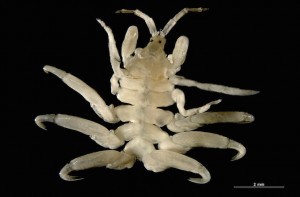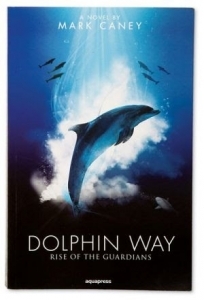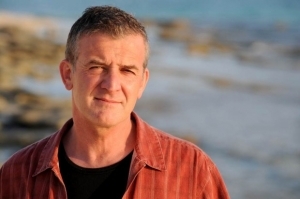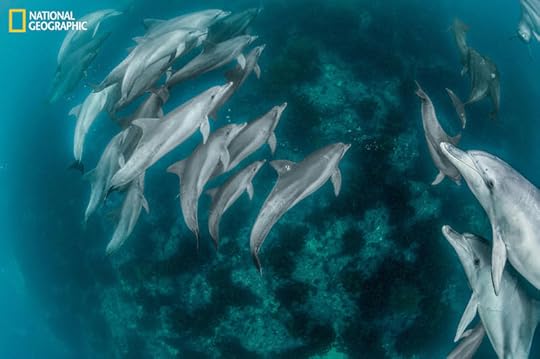Mark Caney's Blog, page 14
July 12, 2015
Can female dolphins chose which males impregnate them?
From article Diane Kelly on Throb
A couple of months ago, I helped out in Patricia Brennan’s lab when she made casts of dolphin vaginas. You heard me correctly. Dolphin vaginas.
Brennan is well-known among biologists for her work on sexual conflict in ducks, and on the internet for her high-speed videos of duck erection. I’ve known Brennan for years – the world of biologists who study the evolution of penises is pretty damn small. Seeking Brennan’s expertise in examining complex, three dimensional models of vaginas, Texas A&M graduate student Dara Orbach traveled all the way to Massachusetts with a crate of frozen dolphin parts. I tagged along to help with the messy, messy work that followed.
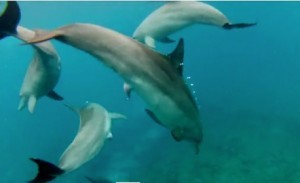 Video of mating dolphins
Video of mating dolphinsOrbach is trying to figure out how female dolphins control which males father their babies.
Like humans, females in many dolphin species mate all year round. But the ocean is big, which means it’s not easy for males to find females while they’re in the fertile part of their cycle. So when they find one, males tend to pile on in groups. When it comes to having sex, male dolphins are kind of assholes.
Dolphins use a number of different gang bang strategies to get a chance at fatherhood. Among bottlenose dolphins, two or three males may form an alliance to ride herd on a female for a few weeks, keeping her close, and away from any other potential mates. Dusky dolphins have a more free-for-all style: four or five males chase after a fertile female, each one trying to get close enough to jam his penis into her vagina during a 5-second schtup-and-run – it’s pure competition, both for the number of times a male gets close enough to copulate and the amount of sperm he can leave inside a female each time.
Female dolphins can try to avoid the pile-ons. They can try to outswim males; they can slap them in the head with their tails; or they can roll onto their backs at the surface of the water, putting their ladybits in the air and out of reach. But it’s a limited menu for choosing who will be the father of the next baby dolphin. Orbach is trying to figure out whether female dolphins, like female ducks, can also exercise a preference for a particular male during sex.
Female ducks manage that feat with a twisted, complex vaginal canal that can shunt unwanted male attention–and sperm–into blind alleys far from their eggs. And biologists already knew that dolphin vaginas, when opened up in dissection, contained a series of muscular flaps and ridges. What we didn’t know was how those flaps and ridges were arranged in three dimensions.
There was really only one way to find out. And it involved a lot of silicone, along with several dolphin vaginas.
We started by setting up frames to hang the vaginal tracts inside once they were filled, weighed down with anything remotely heavy we could find in the lab space. (That’s why you’ll see a big wrench in the film above.)
We popped a cylinder of silicone and curing agent into a caulking gun, and squeezed the goo into the open end of each vagina. Casting was a two-person operation: one pushed the silicone mix out of the gun while the other massaged the outer walls of the vagina and got the casting material into all its cavities and folds. Once the vagina was completely full, we pushed a wooden popsicle stick through the center of the silicon to provide support to the mold when we pulled it out again, and left it hanging in the frame to cure.
After about 40 minutes, the silicone set. Now came the biggest challenge: removing the cast from the vagina without damaging the tissue. We couldn’t just cut it free: dolphin tissue is hard to get hold of, and Orbach needed to save what she had for other parts of her study. We squeezed, and pulled, and peeled, and squeezed, and gently rotated the tissue until the cast came free.
We were amazed at the results. What look like semi-random muscular flaps in a cut and flattened vagina are actually the framework surrounding a beautiful spiral space. This is not your standard mammalian tube.
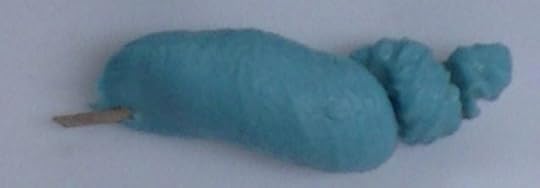
What do the spirals mean for dolphin sex? Will they let female dolphins control where a penis goes, the way a duck vagina does? We won’t know until Orbach does her analysis. We’ll be watching her research to find out more.

June 30, 2015
Mysterious 2,000-year-old marble dolphin surfaces near Gaza
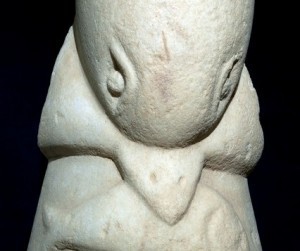 You would think that 12 miles inland from the Mediterranean Sea is the last place to find a dolphin clutching a fish between its jaws.
You would think that 12 miles inland from the Mediterranean Sea is the last place to find a dolphin clutching a fish between its jaws.
Hewn from marble, the 2,000-or-so-year-old statuette surfaced during archaeological excavations near Kibbutz Magen, bordering the Gaza Strip, in March of this year
The discovery of the dolphin statue amid the ruins of a late Byzantine and early Islamic site in the northern Negev was only announced this week by Israel’s Antiquities Authority.
Alexander Fraiberg, head archaeologist with the IAA team, said he believes the sculpture dates to the Roman era, but was incorporated into a later, Byzantine-era paved floor alongside other spolia.
“It’s interesting because the statuette was lying face down, so it was impossible to see its appearance,” he said.
Standing about 16 inches high, experts believe the dolphin may have been part of a larger sculpture, possibly a life-size statue of a god or goddess.
“It’s possible that the [full] statue was of the [Greek] goddess of love and beauty, Aphrodite, who was born from seafoam,” Dr. Rina Avner, an IAA archaeologist specializing in the Roman and Byzantine periods, said.
Statues of Aphrodite, such as the Aphrodite Pudica with Eros Astride a Dolphin at the Dayton Art Institute, depict her alongside a cetacean, symbolizing her origins.
“It’s also possible that the statue was of Poseidon, god of the sea,” who was typically depicted along with dolphins in Classical iconography, Avner added.
Source: Times of Israel

June 28, 2015
Animal rights campaigners demand ‘Nancy the dolphin carer’ dolls are removed from shelves
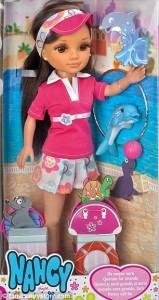 Campaigners have called for ‘Nancy the dolphin carer’ dolls to be removed from shelves in Spain over claims it promotes the exploitation of animals.
Campaigners have called for ‘Nancy the dolphin carer’ dolls to be removed from shelves in Spain over claims it promotes the exploitation of animals.
A petition has been launched demanding that Spanish toymaker Famosa recalls the toy, which retails for the equivalent of £24.
The Catalonia-based animal rights group Associació Cetàcea has called the sale of the doll ‘a backward step’.
According to The Local, the doll comes with accessories including a bucket, hoop and handbag and is one of the toymaker’s most popular products.
Famosa has denied that the doll is meant to be a dolphin trainer.
But in its petition, Associació Cetàcea wrote: ‘It represents a step backwards in terms of all those values animal lovers want to pass on to new generations.’
And it told the Spanish Huffington Post that the doll ‘promotes the exploitation of animals’ and that dolphins in captivity suffer ‘high levels of stress and depression’.
The Local, which says the doll’s packaging features an image of a dolphin leaping through a hoop, quotes a Famosa spokesman as saying that Nancy is a ‘carer, not a trainer’.
‘The doll has absolutely nothing to do with dolphins in captivity,’ the spokesman said.
‘The hope is that the doll will transmit the importance of animal life and the need for professionals to take care of dolphins with all the guarantees that they will be released back into their natural habitat.’
More than 1,250 people have already signed the petition since it was set up on the website change.org.
Source: Mail Online

June 22, 2015
Intelligent Animals: new review of Dolphin Way
Latest review of Dolphin Way on Amazon by C L Hulett:
The concept of intelligent animals not something new but this is handled well. The characters have varying personalities just like humans but have built a society that accepts and uses the differences. They can’t understand why humans will not stop destroying the environment (neither can I) and face different ways of fighting for survival. Anthropomorphic? Absolutely! but may that is the only way we can step outside of ourselves and face what we have done to the planet including the Ocean.

June 18, 2015
Creatures that Live on Dolphins and Whales: Photos
June 16, 2015
Win a copy of Dolphin Way in free competition
Goodreads Book Giveaway

Dolphin Way
by Mark Caney
Giveaway ends August 01, 2015.
See the giveaway details
at Goodreads.

June 15, 2015
Dolphin Way reviewed on Go Freediving
Dolphin Way, Rise of the Guardians is an extraordinary novel taking you into the heart of a millennia-old dolphin culture and society.
When The Way is followed, there is food for all and natural balance reigns. However, the world around them is changing; food stocks are dwindling, the sea temperature is changing, pollution and litter is killing sea life. Some dolphins blame the ‘walkers’, strange creatures who seem ignorant of their impact on the ocean, but some blame other dolphins for fishing more than their quota.
Rise of the Guardians
At the same time, another group of dolphins have emerged: The Guardians. Feared and shunned in equal measure, they no longer follow The Way and believe that the Zetii, bottlenose dolphins, should claim their birthright and dominate all other species. To make contact with a Guardian means instant banishment from your clan.
The story opens with the death of a dolphin, the gifted Born into Summer, drivenonto a beach to die in suspicious circumstances. The book’s hero, Touches the Sky, is determined to find out what happened to her. A young male dolphin navigating his path to adulthood, he’s lost his family and nearly his own life after being driven onto a beach himself by strange soundings underwater many years ago.
By questioning his clan’s explanation for her death he sets himself on a collision course with the clan elders, his friends, and the powerful and ruthless Guardians.
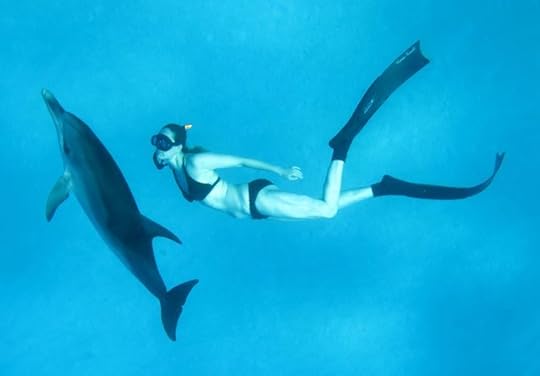
Dolphin art and science
Mark Caney, in his debut novel has created a fully realised world, where dolphin culture has structure, art, science, history and a philosophy of The Way. Running alongside the gripping story that winds itself tighter and tighter is a beautifully realised exploration of the sea, love, friendship and loyalty. There are wonderful meditative sections on breathing, stillness and deep diving that will resonate with all freedivers and people looking for a sense of inner peace.
Dolphin Way, Rise of the Guardians is a mythical story, evoking the hero’s journey, identity, belonging and what happens when all your certainty and belief systems are thrown into question. The story ends with more questions and more beginnings. It leaves the reader wanting to know more: what will happen next and how Touches the Sky, his friends, culture, and the world of Ocean will survive.
Dolphin Way, Rise of the Guardians By Mark Caney
Aquapress 2011 ISBN 978-1-90549-223-7
Watch the trailer for the book here:

June 14, 2015
Video: In the World of Hawaiis Spinners
June 9, 2015
June 6, 2015
Inside The Complicated & Expensive Process Of Returning Captive Dolphins To The Wild
Returning captive dolphins to the wild is not as simple as opening up the gate and letting the mammal return to the sea. Living in captivity, under the close supervision and care of humans literally turns their world upside down. Dolphins in captivity spend most of their time near the surface of the water, receiving food and commands from their trainers in regular intervals. In order to reacclimatize them to wild, they have to be taught to hunt for their meals, and reset their internal clocks to the unpredictable nature of the ocean.
Click here to listen to interview withTim Zimmermann about the process of retraining dolphins to survive in the wild. He has written extensively about the captive dolphin and killer whale industry and is the author of National Geographic’s June feature story: “Born to Be Wild.” Tim is also the associate producer and co-writer of the documentary Blackfish.
From National Geographic



